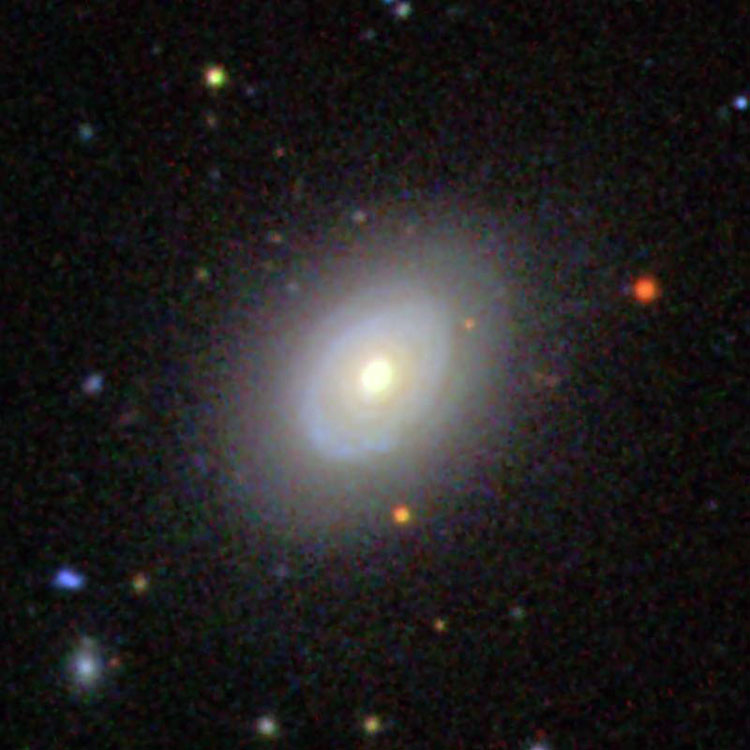New General Catalog Objects: NGC 5450 (original) (raw)
QuickLinks:
5450, 5451, 5452, 5453, 5454, 5455, 5456, 5457, 5458, 5459, 5460, 5461, 5462, 5463, 5464, 5465, 5466,
5467, 5468, 5469, 5470, 5471, 5472, 5473, 5474, 5475, 5476, 5477, 5478, 5479, 5480, 5481, 5482, 5483,
5484, 5485, 5486, 5487, 5488, 5489, 5490, 5491, 5492, 5493, 5494, 5495, 5496, 5497, 5498, 5499
Page last updated Nov 1, 2021
Checked "final" Corwin positions, NGC entries
Added selected designations for "NGC" entries, checked Steinicke discovery dates
WORKING 5463+: Check other historical references (including Gottlieb)
NEXT: Add enough images to clarify classifications
NEXT: Check Dreyer NGC/IC1/IC2 notes, 1912 papers
NGC 5450 (includes NGC 5447), a star cloud in M101
(= PGC 165626)
Discovered (Apr 14, 1789) by William Herschel (and later listed as NGC 5447)
Discovered (Mar 1, 1851) by Bindon Stoney (and later listed as NGC 5450)
Perhaps also observed (Mar 1, 1851) by George Stoney (and later listed as NGC 5450)
Also observed (April 29 to May 12, 1861) by Samuel Hunter (and later listed as NGC 5450)
A magnitude 13.0 star cloud in M101, in Ursa Major (RA 14 02 30.7, Dec +54 16 00)
Historical Identification: Per Dreyer, NGC 5450 (= GC 3763, 3rd Lord Rosse, 1860 RA 13 57 33, NPD 35 05.9) is "faint, pretty small, irregularly round, gradually a little brighter middle, connected with M101."
Discovery Notes: Although Dreyer credits the discovery to William Parsons, 3rd Earl of Rosse, he notes that many of Rosse's nebular discoveries were actually made by one of his assistants, in this case Bindon Stoney. It is also possible that Bindon's brother, George Johnstone Stoney, was present at the time that Bindon made the sketch that gives Bindon discovery credit, for although GJ was studying at Trinity College at the time, per Gottlieb, George spent 15 out of about 20 weekends at Birr Castle during the spring observing season of 1851, and since Mar 1, 1851 was a Saturday, there is a good chance that the brothers took turns observing M101 on the night in question. Also per Gottlieb, John Herschel estimated the positions of various "knots" in M101 using a sketch made by Samuel Hunter and measures of position and distance of nearby stars, hence my inclusion of Hunter's name in the list of observers. Corwin also used Hunter's sketch (published in Lord Rosse's compilation of all observations made with the 72-inch "Leviathan") to better determine the positions, and it is on the basis of his work that most of the objects with poor positions have been identified.
Corwin Positions: Corwin lists positions for five different portions of this star-forming region, one of which is NGC 5447.
Physical Information:

Above, a 26 arcmin wide SDSS image of M101, showing its extended arms
Below, the image above showing labels for NGC objects "connected with" the galaxy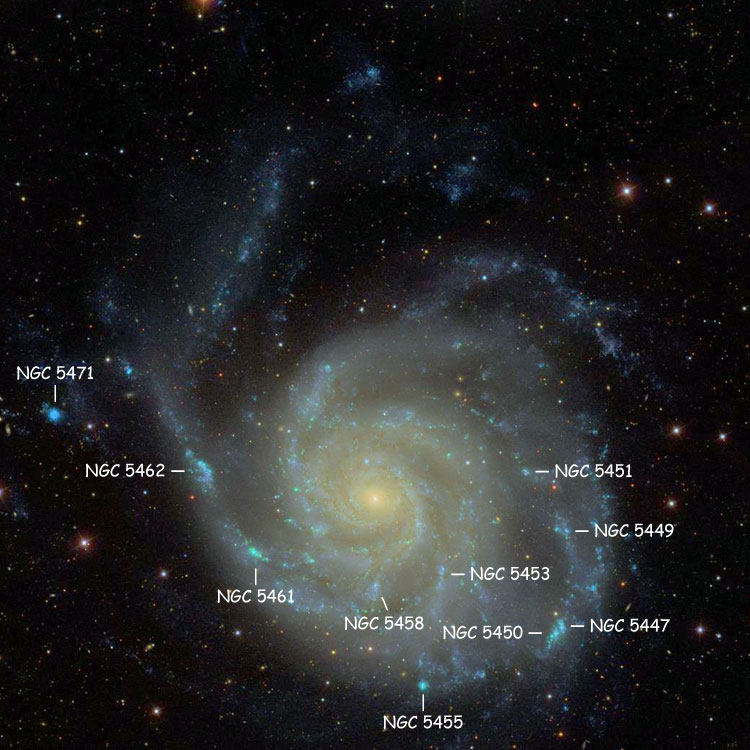
Below, a 2 arcmin wide SDSS image centered on NGC 5450 (the northeastern portion is listed as NGC 5447)
NGC 5451, a star cloud in M101
(= "PGC 3517704")
Recorded (Mar 1, 1851) by Bindon Stoney
Perhaps also observed (Mar 1, 1851) by George Stoney
Also observed (April 29 to May 12, 1861) by Samuel Hunter
A magnitude 14.0 star cloud in M101, in Ursa Major (RA 14 02 36.6, Dec +54 21 49)
Historical Identification: Per Dreyer, NGC 5451 (= GC 3764, 3rd Lord Rosse, 1860 RA 13 57 42, NPD 34 57.7) is "very faint, pretty large, irregularly round, a very little brighter middle, connected with M101."
Discovery Notes: Although Dreyer credits the discovery to William Parsons, 3rd Earl of Rosse, he notes that many of Rosse's nebular discoveries were actually made by one of his assistants, in this case Bindon Stoney. It is also possible that Bindon's brother, George Johnstone Stoney, was present at the time that Bindon made the sketch that gives Bindon discovery credit, for although GJ was studying at Trinity College at the time, per Gottlieb, George spent 15 out of about 20 weekends at Birr Castle during the spring observing season of 1851, and since Mar 1, 1851 was a Saturday, there is a good chance that the brothers took turns observing M101 on the night in question. Also per Gottlieb, John Herschel estimated the positions of various "knots" in M101 using a sketch made by Samuel Hunter and measures of position and distance of nearby stars, hence my inclusion of Hunter's name in the list of observers. Corwin also used Hunter's sketch (published in Lord Rosse's compilation of all observations made with the 72-inch "Leviathan") to better determine the positions, and it is on the basis of his work that most of the objects with poor positions have been identified.
Note About PGC Designation: As for most NGC entries, HyperLEDA assigned a PGC designation to this object, even though it isn't a galaxy; but a search of the database for that designation returns no result, hence its being shown in quotes.
Corwin Positions: Corwin lists three positions for different portions of this star-forming region.
Physical Information:

Above, a 26 arcmin wide SDSS image of M101, showing its extended arms
Below, the image above showing labels for NGC objects "connected with" the galaxy
Below, a 2 arcmin wide SDSS image of NGC 5451
NGC 5452
(= PGC 49426 = UGC 8867 = CGCG 353-028 = MCG +13-10-014)
Discovered (Dec 20, 1797) by William Herschel
Also observed (May 5, 1831) by John Herschel
A magnitude 13.3 spiral galaxy (type SAB(s)cd?) in Ursa Minor (RA 13 54 24.9, Dec +78 13 15)
Historical Identification: Per Dreyer, NGC 5452 (= GC 3765 = JH 1747 = WH III 947, 1860 RA 13 57 44, NPD 11 05.9) is "very faint, pretty large, irregularly round, very gradually a very little brighter middle."
Physical Information: Apparent size 1.45 by 1.0 arcmin (from the images below).
LEDA SABc; NED SAB(s)d, RIDE2 33.0 - 33.1 Mpc, 2.0 by 1.5 arcmin, 3K Vr 2079 km/sec
Below, a 1.75 arcmin wide PanSTARRS image of NGC 5452
NGC 5453, a star cloud in M101
(= "PGC 3517705")
Discovered (Mar 1, 1851) by Bindon Stoney
Perhaps also observed (Mar 1, 1851) by George Stoney
Also observed (April 29 to May 12, 1861) by Samuel Hunter
Not observed (1898) by Hermann Kobold
A magnitude 13.8 star cloud in M101, in Ursa Major (RA 14 02 56.6, Dec +54 18 20)
Historical Identification: Per Dreyer, NGC 5453 (= GC 3767, 3rd Lord Rosse, 1860 RA 13 58 00, NPD 35 02.1) is "faint, pretty large, a little extended, a very little bright middle, connected with M101."
Discovery Notes: Although Dreyer credits the discovery to William Parsons, 3rd Earl of Rosse, he notes that many of Rosse's nebular discoveries were actually made by one of his assistants, in this case Bindon Stoney. It is also possible that Bindon's brother, George Johnstone Stoney, was present at the time that Bindon made the sketch that gives Bindon discovery credit, for although GJ was studying at Trinity College at the time, per Gottlieb, George spent 15 out of about 20 weekends at Birr Castle during the spring observing season of 1851, and since Mar 1, 1851 was a Saturday, there is a good chance that the brothers took turns observing M101 on the night in question. Also per Gottlieb, John Herschel estimated the positions of various "knots" in M101 using a sketch made by Samuel Hunter and measures of position and distance of nearby stars, hence my inclusion of Hunter's name in the list of observers. Corwin also used Hunter's sketch (published in Lord Rosse's compilation of all observations made with the 72-inch "Leviathan") to better determine the positions, and it is on the basis of his work that most of the objects with poor positions have been identified. Finally, per Gottlieb, Kobold's observation, though accurately measured, was not of NGC 5453, as he thought, but of an uncatalogued knot about halfway between NGC 5453 and the nucleus of M101.
Note About PGC Designation: As for most NGC entries, HyperLEDA assigned a PGC designation to this object, even though it isn't a galaxy; but a search of the database for that designation returns no result, hence its being shown in quotes.
Corwin Positions: Corwin lists five positions for different portions of this star-forming region.
Physical Information:

Above, a 26 arcmin wide SDSS image of M101, showing its extended arms
Below, the image above showing labels for NGC objects "connected with" the galaxy
Below, a 2 arcmin wide SDSS image of NGC 5453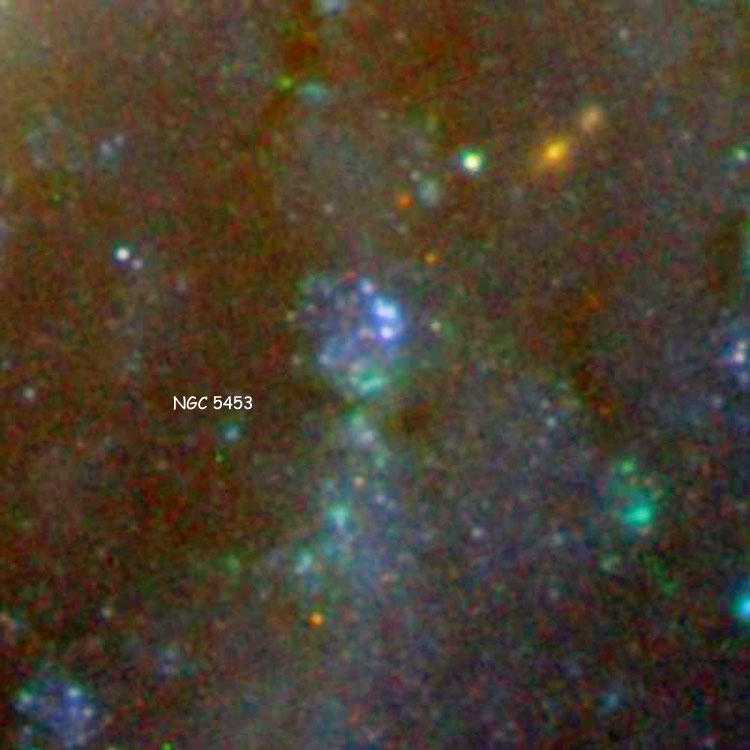
NGC 5454
(= PGC 50192 = UGC 8997 = CGCG 103-064 = MCG +03-36-042)
Discovered (Apr 21, 1865) by Heinrich d'Arrest
A magnitude 12.7 lenticular galaxy (type S0?) in Bo�tes (RA 14 04 45.7, Dec +14 22 55)
Historical Identification: Per Dreyer, NGC 5454 (= GC 5756, d'Arrest, 1860 RA 13 58 00, NPD 74 56.8) is "pretty faint, small."
Physical Information: Apparent size 1.5 by 0.9 arcmin.
Below, a 1.75 arcmin wide SDSS image centered on NGC 5454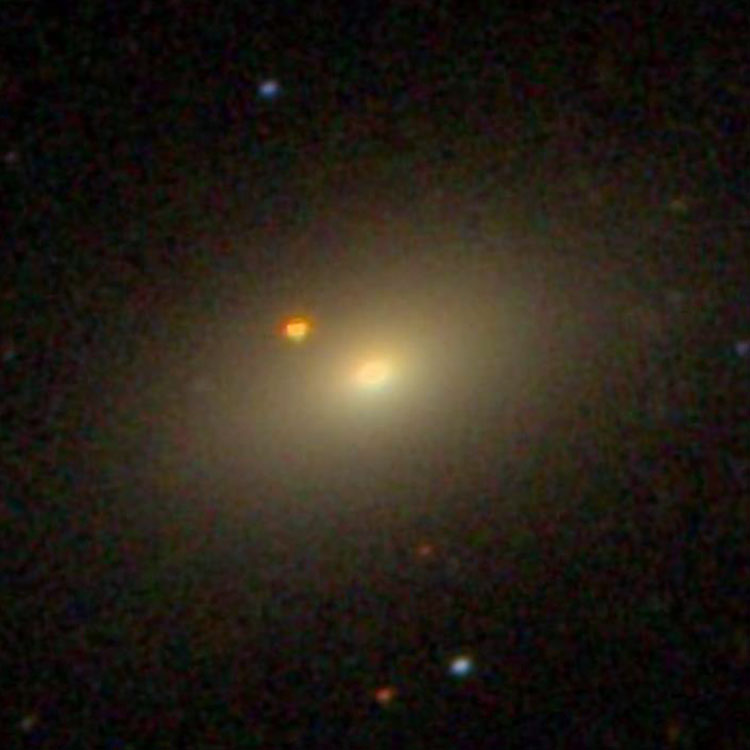
NGC 5455, a star-forming region in M101
(= PGC 3517706")
Discovered (Mar 1, 1851) by Bindon Stoney
Perhaps also observed (Mar 1, 1851) by George Stoney
Also observed (April 29 to May 12, 1861) by Samuel Hunter
Also observed (1898) by Hermann Kobold
A magnitude 13.0 star-forming region in M101, in Ursa Major (RA 14 03 01.2, Dec +54 14 27)
Historical Identification: Per Dreyer, NGC 5455 (= GC 3768, 3rd Lord Rosse, 1860 RA 13 58 03, NPD 35 08.3) is "pretty bright, pretty small, round, pretty suddenly brighter middle, connected with M101."
Discovery Notes: Although Dreyer credits the discovery to William Parsons, 3rd Earl of Rosse, he notes that many of Rosse's nebular discoveries were actually made by one of his assistants, in this case Bindon Stoney. It is also possible that Bindon's brother, George Johnstone Stoney, was present at the time that Bindon made the sketch that gives Bindon discovery credit, for although GJ was studying at Trinity College at the time, per Gottlieb, George spent 15 out of about 20 weekends at Birr Castle during the spring observing season of 1851, and since Mar 1, 1851 was a Saturday, there is a good chance that the brothers took turns observing M101 on the night in question. Also per Gottlieb, John Herschel estimated the positions of various "knots" in M101 using a sketch made by Samuel Hunter and measures of position and distance of nearby stars, hence my inclusion of Hunter's name in the list of observers. Corwin also used Hunter's sketch (published in Lord Rosse's compilation of all observations made with the 72-inch "Leviathan") to better determine the positions, and it is on the basis of his work that most of the objects with poor positions have been identified. Finally, per Gottlieb, Kobold measured an accurate position in 1898, "though it wasn't published until 1907."
Note About PGC Designation: As for most NGC entries, HyperLEDA assigned a PGC designation to this object, even though it isn't a galaxy; but a search of the database for that designation returns no result, hence its being shown in quotes.
Physical Information:

Above, a 26 arcmin wide SDSS image of M101, showing its extended arms
Below, the image above showing labels for NGC objects "connected with" the galaxy
Below, a 1 arcmin wide SDSS image of NGC 5455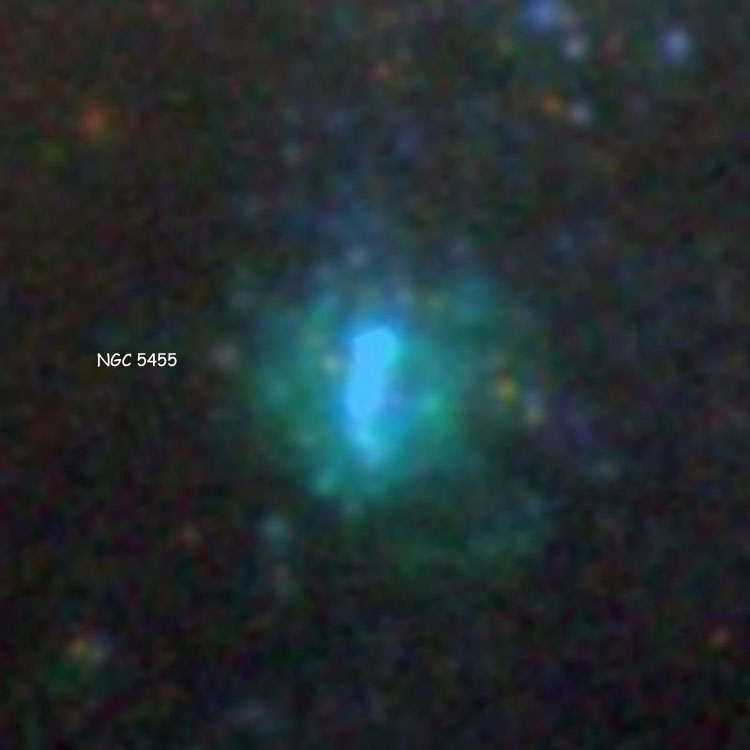
NGC 5456
(= PGC 50213 = UGC 9004 = CGCG 074-089 = MCG +02-36-036)
Discovered (Feb 7, 1862) by Heinrich d'Arrest
A magnitude 12.9 lenticular galaxy (type S0?) in Bo�tes (RA 14 04 58.9, Dec +11 52 18)
Historical Identification: Per Dreyer, NGC 5456 (= GC 3769, d'Arrest, 1860 RA 13 58 08, NPD 77 27.4) is "faint, pretty small."
Physical Information: Apparent size 1.2 by 1.0 arcmin.
Below, a 1.5 by 1.75 arcmin wide SDSS image centered on NGC 5456
NGC 5457 (= M101 = Arp 26), The Pinwheel Galaxy
(= PGC 50063 = UGC 8981 = CGCG 272-021 = MCG +09-23-028)
Discovered (Mar 27, 1781) by Pierre M�chain
Recorded (without observational verification) by Charles Messier as M101
Also observed (later in 1781) by Charles Messier
Also observed (Apr 14, 1789) by John Herschel
Also observed (May 4, 1831) by John Herschel
Also observed (Mar 1, 1851) by Bindon Stoney
Perhaps also observed (Mar 1, 1851) by George Stoney
Also observed (April 29 to May 12, 1861) by Samuel Hunter
A magnitude 7.9 spiral galaxy (type SAB(rs)cd?) in Ursa Major (RA 14 03 12.5, Dec +54 20 56)
Historical Identification: Per Dreyer, NGC 5457 (= GC 3770 = JH 1744, M101, 1860 RA 13 58 14, NPD 34 58.6) is "pretty bright, very large, irregularly round, gradually, then very suddenly much brighter middle with bright small nucleus." The position precesses to RA 14 03 11.5, Dec +54 20 58, essentially dead center on the galaxy listed above and the description fits, so the identification is certain.
Discovery Information: Usually Messier verified discoveries reported to him by M�chain, and listed both his friend's prior discovery and his own observation. However, at the time of M�chain's observation of what became M101, the deadline for additions to the 1784 publication of Messier's last Catalog was fast approaching, so he did not verify the observation until later. Messier's description of the object was only recorded (without the date of his observation) in a handwritten note in his personal copy of the printed version. (A similar situation applies to M102 and M103, the last objects recorded by Messier.)
Discovery Note: Per Gottlieb, Bindon Stoney made a detailed sketch of the galaxy, and is credited as the discoverer of numerous knots shown in that sketch, hence my addition of Stoney to the list of observers. It is also possible that Bindon's brother, George Johnstone Stoney, was present at the time that Bindon made the sketch that gives Bindon discovery credit, for although GJ was studying at Trinity College at the time, per Gottlieb, George spent 15 out of about 20 weekends at Birr Castle during the spring observing season of 1851, and since Mar 1, 1851 was a Saturday, there is a good chance that the brothers took turns observing M101 on the night in question. Also per Gottlieb, John Herschel estimated the positions of various "knots" in M101 using a sketch made by Samuel Hunter and measures of position and distance of nearby stars, hence my inclusion of Hunter's name in the list of observers. Corwin also used Hunter's sketch (published in Lord Rosse's compilation of all observations made with the 72-inch "Leviathan") to better determine the positions, and it is on the basis of his work that most of the objects that are just part of M101 have been identified.
Use By The Arp Atlas: NGC 5457 is listed in Halton Arp's Atlas of Peculiar Galaxies as Arp 26, an example of a spiral galaxy with one heavy arm. Physical Information: M101's recessional velocity of only 240 km/sec is too small in comparison to peculiar (non-Hubble-expansion) velocities to provide a reliable estimate of its distance. Redshift-independent distance estimates range from 18 to 29 million light years. Given that and its apparent size of 28 by 26 arcmin (nearly the same size as the full moon), M101 is nearly 200 thousand light years across.

Above, a 26 arcmin wide SDSS image of M101, showing its extended arms
Below, the image above showing labels for NGC objects "connected with" the galaxy
Below, a 17.5 arcmin wide HST image of M101 (Image Credit NASA, ESA, CXC, SSC, and STScI)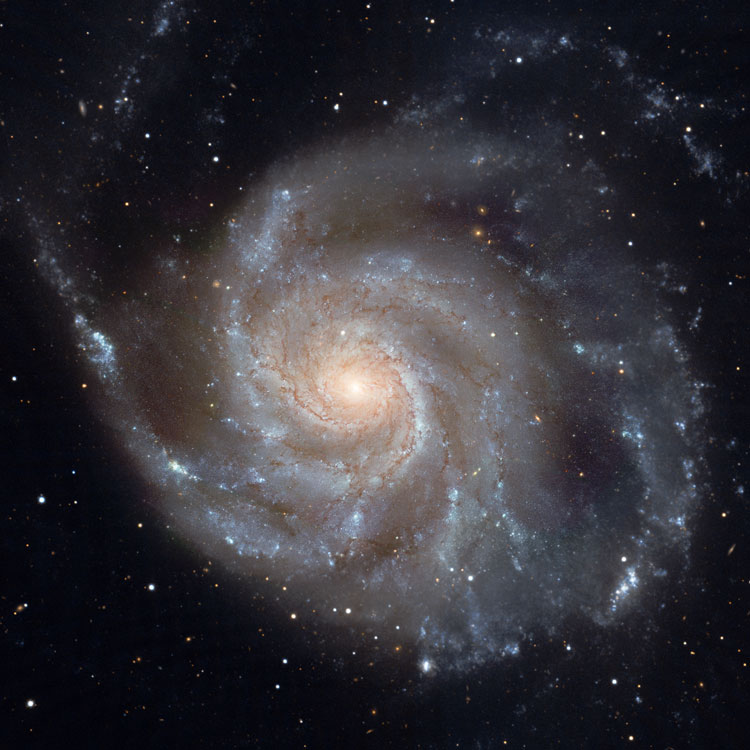
Below, an 8 by 8.5 arcmin wide HST image of the center of the galaxy
(Image Credit NASA, ESA, K. Kuntz (JHU), F. Bresolin (U. of Hawaii), J. Trauger (JPL), J. Mould (NOAO), Y.-H. Chu (U. of Illinois Urbana), STSci)
Below, a 20 by 24 arcmin wide infrared image of M101 taken with the Spitzer Space Telescope
(Image credit NASA, JPL-Caltech, K. Gordon (STScI) et al., NASA)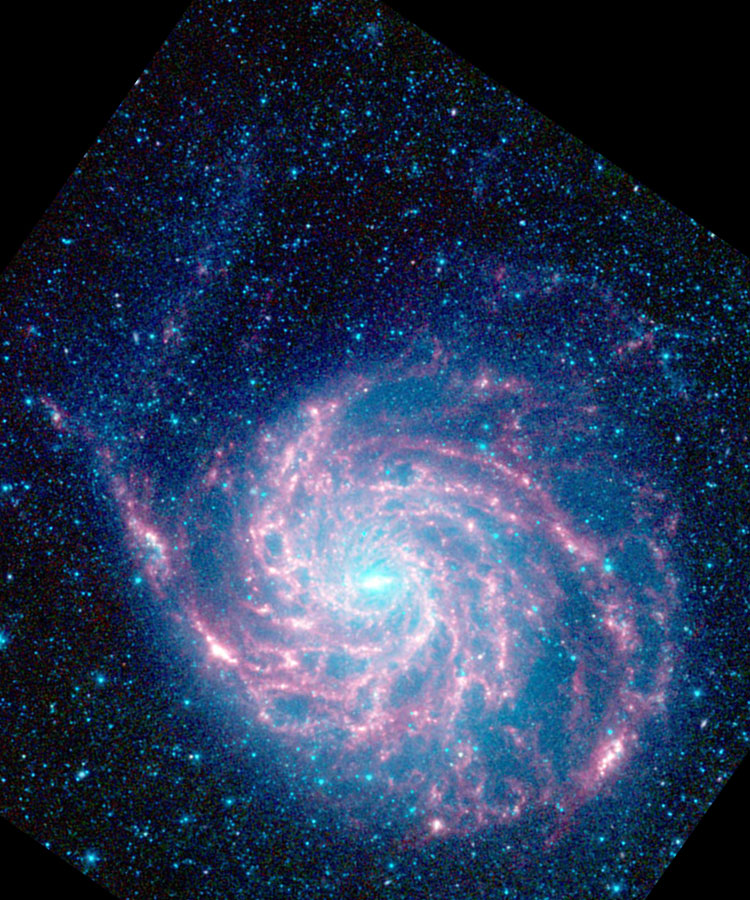
NGC 5458, a star-forming region in M101
(= "PGC 3517707")
Discovered (Mar 1, 1851) by Bindon Stoney
Perhaps also observed (Mar 1, 1851) by George Stoney
Also observed (April 29 to May 12, 1861) by Samuel Hunter
A magnitude 14.0 star-forming region in M101, in Ursa Major (RA 14 03 12.5, Dec +54 17 55)
Historical Identification: Per Dreyer, NGC 5458 (= GC 3771, 3rd Lord Rosse, 1860 RA 13 58 15, NPD 35 04.0) is "very faint, pretty large, round, a very little brighter middle, connected with M101."
Discovery Notes: Although Dreyer credits the discovery to William Parsons, 3rd Earl of Rosse, he notes that many of Rosse's nebular discoveries were actually made by one of his assistants, in this case Bindon Stoney. It is also possible that Bindon's brother, George Johnstone Stoney, was present at the time that Bindon made the sketch that gives Bindon discovery credit, for although GJ was studying at Trinity College at the time, per Gottlieb, George spent 15 out of about 20 weekends at Birr Castle during the spring observing season of 1851, and since Mar 1, 1851 was a Saturday, there is a good chance that the brothers took turns observing M101 on the night in question. Also per Gottlieb, John Herschel estimated the positions of various "knots" in M101 using a sketch made by Samuel Hunter and measures of position and distance of nearby stars, hence my inclusion of Hunter's name in the list of observers. Corwin also used Hunter's sketch (published in Lord Rosse's compilation of all observations made with the 72-inch "Leviathan") to better determine the positions, and it is on the basis of his work that most of the objects with poor positions have been identified.
Note About PGC Designation: As for most NGC entries, HyperLEDA assigned a PGC designation to this object, even though it isn't a galaxy; but a search of the database for that designation returns no result, hence its being shown in quotes.
Physical Information:

Above, a 26 arcmin wide SDSS image of M101, showing its extended arms
Below, the image above showing labels for NGC objects "connected with" the galaxy
Below, a 1 arcmin wide SDSS image of NGC 5458
NGC 5459
(= PGC 50215 = UGC 9005 = CGCG 074-090 = MCG +02-36-037)
Discovered (Mar 23, 1887) by Lewis Swift (and later listed as NGC 5459)
Also observed (May 26, 1894) by Guillaume Bigourdan (while listed as NGC 5459)
A magnitude 13.1 lenticular galaxy (type S0?) in Bo�tes (RA 14 05 00.2, Dec +13 07 55)
Historical Identification: Per Dreyer, NGC 5459 (Swift list VI (#64), 1860 RA 13 58 17, NPD 76 11.6) is "faint, small, a little extended, pretty bright star south-preceding (to the southwest)." The second IC lists a corrected RA (per Bigourdan) of 13 58 32, but per Gottlieb that includes a 20 second recording error by Dreyer; Bigourdan's actual position was (1860) RA 13 58 12, Dec +13 47 54 = (2000) RA 14 04 59.5, Dec +13 07 34, less than 0.4 arcmin southwest of the center of the galaxy listed above and on its southwestern rim, the description fits and there is nothing else nearby, so the identification is certain.
Physical Information: Apparent size of 1.1 by 1.0 arcmin.
Below, a 1.5 arcmin wide SDSS image of the galaxy
NGC 5460
(= OCL 925 = "PGC 3518317")
Discovered (May 7, 1826) by James Dunlop
Also observed (Aug 6, 1831) by John Herschel
A magnitude 5.6 open cluster (type II3m) in Centaurus (RA 14 07 10, Dec -48 21 30)
Historical Identification: Per Dreyer, NGC 5460 (= GC 3772 = JH 3555, Dunlop #431, 1860 RA 13 58 40, NPD 137 38.9) is "a cluster, very large, very little compressed, stars from 8th magnitude downwards." The position precesses to RA 14 07 36.6, Dec -48 19 05, near a curved arc of about half a dozen bright stars. (The traditional "position" was for the more or less central double star in the arc.) There are a number of other stars of similar brightness to the south and northwest, and some references cite a diameter for NGC 5460 that includes all of the brighter stars in the region.
Discovery Note: Per Gottlieb, Herschel first observed this "very coarse cluster" on the date shown above, and two nights later wrote "Place of a double star in a semi-elliptic group forming part of it, but insulated in a large scattered cluster or tract of bright stars." The observation referred to in the NGC (JH 3555) was made on July 1, 1834, and as a result, that is the date usually given for Herschel's observation. Gottlieb quotes from his note for that night, "a region of large stars very loosely distributed, but which yet decidedly form a cluster... The cluster is 30 arcmin diameter, and is divided into distinct groups."
Note About PGC Designation: As for most NGC objects, HyperLEDA assigned a PGC designation for this object, even though it isn't a galaxy; but a search of the database for that designation returns no result, hence its being shown in quotes.
Physical Information: Apparent size about 30 arcmin (whence the size chosen for the image below).
Below, a 30 arcmin wide DSS image centered on NGC 5460; the galaxy behind the arc of stars to left of center is PGC 50388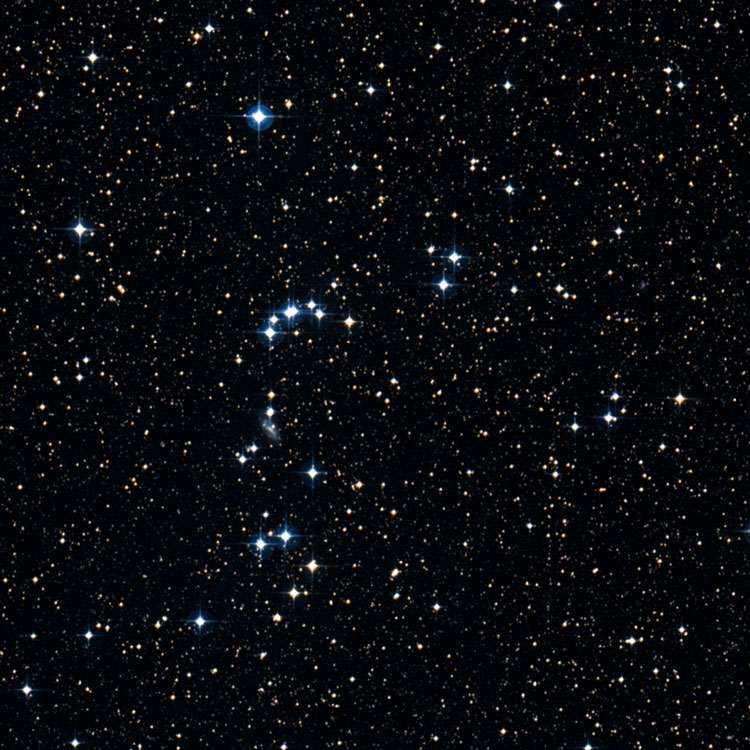
PGC 50388
(= ESO 221-025)
Not an NGC object but listed here because seen behind NGC 5460
A magnitude 14(?) spiral galaxy (type SB(s)c?) in Centaurus (RA 14 07 35.18, Dec -48 23 40)
Physical Information: Apparent size of about 1.0 by 0.5 arcmin (from the image below).
LEDA Sbc, B 14.61, I 12.82 -> V 14(?); NED SB(s)bc: 1.4x.6 arcmin, 3K Vr 3165 km/sec; Corwin SB(s)cd
Below, a 1.75 arcmin wide DSS image of PGC 50388
NGC 5461, a star cloud in M101
(= PGC 165627)
Discovered (Apr 14, 1789) by William Herschel
Also observed (Apr 27, 1851) by Bindon Stoney
Perhaps also observed (Mar 1, 1851) by George Stoney
Also observed (April 29 to May 12, 1861) by Samuel Hunter
Also observed (date?) by Heinrich d'Arrest
A magnitude 14.0 star cloud in M101, in Ursa Major (RA 14 03 39.7, Dec +54 18 57)
Historical Identification: Per Dreyer, NGC 5461 (= GC 3773 = GC 3778 = WH III 788, 3rd Lord Rosse, d'Arrest, 1860 RA 13 58 44, NPD 35 00.5) is "bright, pretty small, round, pretty suddenly brighter middle, connected with M101."
Discovery Notes: Although Dreyer credits the discovery to William Parsons, 3rd Earl of Rosse, he notes that many of Rosse's nebular discoveries were actually made by one of his assistants, in this case Bindon Stoney. It is also possible that Bindon's brother, George Johnstone Stoney, was present at the time that Bindon made the sketch that gives Bindon discovery credit, for although GJ was studying at Trinity College at the time, per Gottlieb, George spent 15 out of about 20 weekends at Birr Castle during the spring observing season of 1851, and since Mar 1, 1851 was a Saturday, there is a good chance that the brothers took turns observing M101 on the night in question. Also per Gottlieb, John Herschel estimated the positions of various "knots" in M101 using a sketch made by Samuel Hunter and measures of position and distance of nearby stars, hence my inclusion of Hunter's name in the list of observers. Corwin also used Hunter's sketch (published in Lord Rosse's compilation of all observations made with the 72-inch "Leviathan") to better determine the positions, and it is on the basis of his work that most of the objects with poor positions have been identified.
Per Gottlieb, Herschel's position was poor, and John Herschel assigned two entries in the GC because he wasn't sure whether Herschel's III 788 was the same as one of the knots sketched by Stoney (knot n2). Dreyer combined the two GC entries in the NGC, and used d'Arrest's accurate position.
Corwin Positions: Corwin lists three positions for different portions of this star-forming region.
Physical Information:

Above, a 26 arcmin wide SDSS image of M101, showing its extended arms
Below, the image above showing labels for NGC objects "connected with" the galaxy
Below, a 2 arcmin wide SDSS image of NGC 5461
NGC 5462, a star cloud in M101
(= "PGC 3517708")
Discovered (Apr 14, 1789) by William Herschel
Also obsered (Apr 27, 1851) by Bindon Stoney
Perhaps also observed (Mar 1, 1851) by George Stoney
Also observed (April 29 to May 12, 1861) by Samuel Hunter
Also observed (date?) by Heinrich d'Arrest
A magnitude 13.5 star cloud in M101, in Ursa Major (RA 14 03 53.5, Dec +54 22 02)
Historical Identification: Per Dreyer, NGC 5462 (= GC 3774 = GC 3779 = WH III 789, 3rd Lord Rosse, d'Arrest, 1860 RA 13 58 58, NPD 34 57.7) is "pretty bright, pretty large, irregular round, gradually brighter middle, connected with M101."
Discovery Notes: Although Dreyer credits the discovery to William Parsons, 3rd Earl of Rosse, he notes that many of Rosse's nebular discoveries were actually made by one of his assistants, in this case Bindon Stoney. It is also possible that Bindon's brother, George Johnstone Stoney, was present at the time that Bindon made the sketch that gives Bindon discovery credit, for although GJ was studying at Trinity College at the time, per Gottlieb, George spent 15 out of about 20 weekends at Birr Castle during the spring observing season of 1851, and since Mar 1, 1851 was a Saturday, there is a good chance that the brothers took turns observing M101 on the night in question. Also per Gottlieb, John Herschel estimated the positions of various "knots" in M101 using a sketch made by Samuel Hunter and measures of position and distance of nearby stars, hence my inclusion of Hunter's name in the list of observers. Corwin also used Hunter's sketch (published in Lord Rosse's compilation of all observations made with the 72-inch "Leviathan") to better determine the positions, and it is on the basis of his work that most of the objects with poor positions have been identified.
As in the case of NGC 5461, Herschel's position was poor, and John Herschel assigned two entries in the GC, being uncertain whether III 789 was the same as the object sketched by Stoney (knot n1). Dreyer combined the two GC entries in the NGC, and used d'Arrest's accurate position.
Corwin Positions: Corwin lists four positions for different portions of this star-forming region. A HyperLEDA search for NGC 5462 returns the object listed here, described as a galaxy part, and labeled with the PGC designation shown above; but a search of the database for that designation returns no result, hence its being shown in quotes.
Physical Information:

Above, a 26 arcmin wide SDSS image of M101, showing its extended arms
Below, the image above showing labels for NGC objects "connected with" the galaxy
Below, a 3 arcmin wide SDSS image of NGC 5462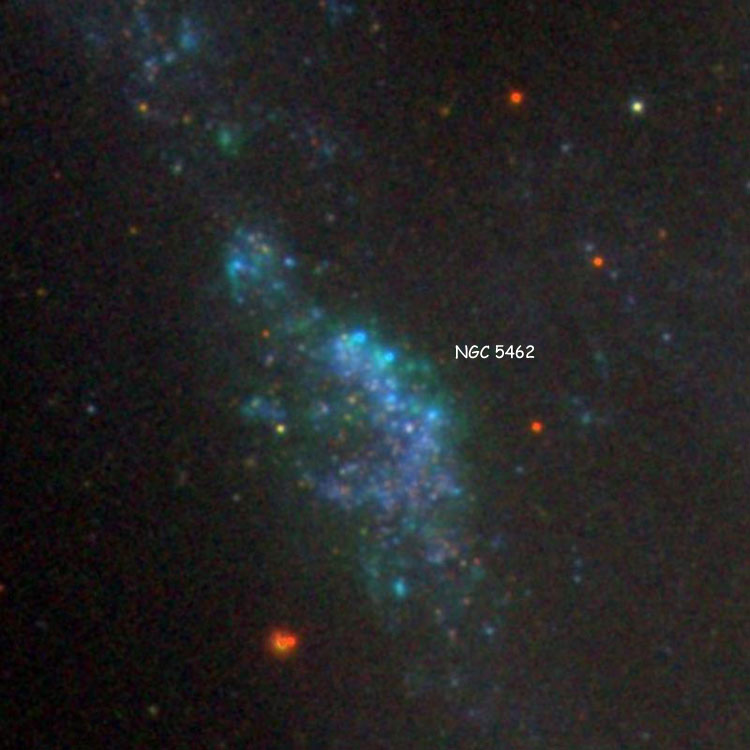
WORKING HERE: Need images for 5463 and possible companionNGC 5463
(= PGC 50299 = UGC 9017 = CGCG 074-102 = MCG +02-36-040)
Discovered (Mar 19, 1784) by William Herschel
Also observed (date?) by Wilhelm Tempel
A magnitude 13.2 spiral galaxy (type S?) in Bo�tes (RA 14 06 10.5, Dec +09 21 12)
Historical Identification: Per Dreyer, NGC 5463 (= GC 3780 = WH III 58, Tempel list VIII, 1860 RA 13 59 00, NPD 79 55.5) is "extremely faint, small, a little extended."
Discovery Note: Per Gottlieb, Tempel's position was 15 seconds of time too far to the west and 3 arcmin too far to the north; but the error was not in his observation, but in his calculations, as "re-reducing his position... yields an accurate match with UGC 9017."
Physical Information: Apparent size 1.2 by 0.5 arcmin.
LEDA SB0; NED S?, 3K Vr 7346 km/sec, z 0.024502899
Below, a ? arcmin wide SDSS image of NGC 5463
"PGC 3819530"
(= 2MASX J14061253+0921412 = "NGC 5463B")
Not an NGC object but listed here because often called NGC 5463B
and perhaps a companion of NGC 5463
A magnitude 15.0 lenticular galaxy (type S(s)0/a pec) in Bo�tes (RA 14 06 12.5, Dec +09 21 42)
Note About PGC Designation: Although a search of the HyperLEDA database for the 2MASX designation (or the non-standard "NGC" designation) yields a page describing this object, a search for the PGC designation assigned to the object by HyperLEDA returns no result, hence that designation being placed in quotes.
Physical Information: Apparent size 0.3 by 0.2 arcmin.
LEDA E3; NED 3K Vr 7622 km/sec, z 0.025424947; perhaps a slightly background galaxy, but given its unusual structure, perhaps a companion of NGC 5463 with a fairly large "peculiar velocity" relative to its larger neighbor.
Classification Note: The galaxy's classification is not given in NED, and HyperLEDA lists it as an elliptical galaxy, but the SDSS image below shows that it has short spiral arms at the eastern and western ends of the galaxy, whence the type shown in the description line.
NGC 5464
(= PGC 50356 = ESO 446-011 = MCG -05-33-045)
Discovered (Mar 30, 1835) by John Herschel
A magnitude 13.0 spiral galaxy (type SBm?) in Hydra (RA 14 07 04.4, Dec -30 01 01)
Historical Identification: Per Dreyer, NGC 5464 (= GC 3775 = JH 3556, 1860 RA 13 59 01, NPD 119 20.5) is "pretty faint, small, round, pretty suddenly a little brighter middle."
Physical Information: Apparent size 1.3 by 0.8 arcmin.
NGC 5465
(= "PGC 5067743")
Recorded (April, 1882) by Wilhelm Tempel
A magnitude 14.8 star in Virgo (RA 14 06 27.3, Dec -05 30 23)
Historical Identification: Per Dreyer, NGC 5465 (Tempel list V, 1860 RA 13 59 08, NPD 94 50.7) is "extremely faint, very small, south-preceding (to the southwest of) III 286," (WH) III 286 being NGC 5468.
Note About PGC Designation: A HyperLEDA search for NGC 5465 returns the object listed here, described as a star, and labeled with the PGC designation shown above; but a search of the database for that designation returns no result, hence its being shown in quotes.
NGC 5466
(= GCL 27 = PGC 2802653)
Discovered (May 17, 1784) by William Herschel
Also observed (Mar 30, 1827) by John Herschel
A magnitude 9.2 globular cluster (type XII) in Bo�tes (RA 14 05 27.4, Dec +28 32 04)
Historical Identification: Per Dreyer, NGC 5466 (= GC 3776 = JH 1746 = WH VI 9, 1860 RA 13 59 09, NPD 60 48.2) is "a cluster, large, very rich, very much compressed, stars from 11th magnitude downwards."
Physical Information: Apparent size 9.0 arcmin.
NGC 5467 (= IC 973)
(= "PGC 5067507")
Recorded (April, 1882) by Wilhelm Tempel (and later listed as NGC 5467)
Recorded (May 21, 1890) by Guillaume Bigourdan (and later listed as IC 973)
A magnitude 15.2 star in Virgo (RA 14 06 29.4, Dec -05 28 54)
Historical Identification: Per Dreyer, NGC 5467 (Tempel list V, 1860 RA 13 59 13, NPD 94 49.2) is "extremely faint, very small, south-preceding (to the southwest of) III 286," (WH) III 286 being NGC 5468.
NGC 5468
(= PGC 50323 = UGCA 384 = MCG -01-36-007)
Discovered (Mar 5, 1785) by William Herschel
Also observed (Apr 16, 1828) by John Herschel
A magnitude 12.5 spiral galaxy (type SAB(rs)cd) in Virgo (RA 14 06 34.9, Dec -05 27 11)
Historical Identification: Per Dreyer, NGC 5468 (= GC 3777 = JH 1745 = WH III 286, 1860 RA 13 59 18, NPD 94 47.5) is "faint, large, round, very gradually brighter middle, 9th magnitude star 4 arcmin south-following (to southeast)." The position precesses to RA 14 06 36.9, Dec -05 27 42, within the southeastern boundary of the galaxy listed above, the description fits perfectly and there is nothing comparable nearby, so the identification is certain.
Physical Information: Based on a recessional velocity relative to the Cosmic Microwave Background of 3110 km/sec (and H0 = 70 km/sec/Mpc), NGC 5468 is about 145 million light years away, in good agreement with redshift-independent distance estimates of about 90 to 165 million light years (the HST press release says "just over 130 million light-years away"). Given that and its apparent size of about 3.0 by 2.75 arcmin (from the images below), the galaxy is about 125 thousand light years across. Thanks to its face-on alignment it is easy to see events taking place in its star-forming regions, and as a result several supernovae have been observed in the galaxy.
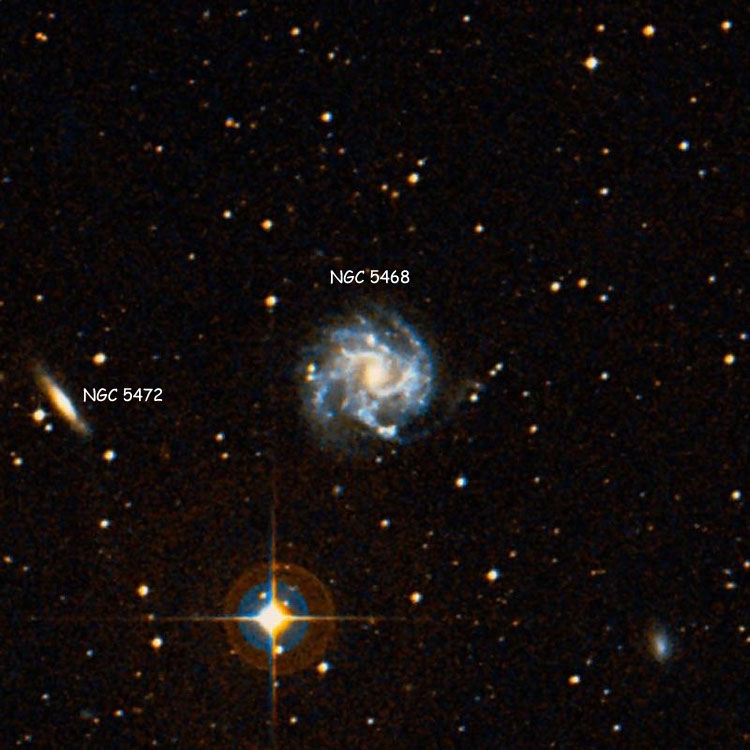
Above, a 12 arcmin wide DSS image centered on NGC 5468, also showing NGC 5472
Below, a 3 arcmin wide DSS image of the galaxy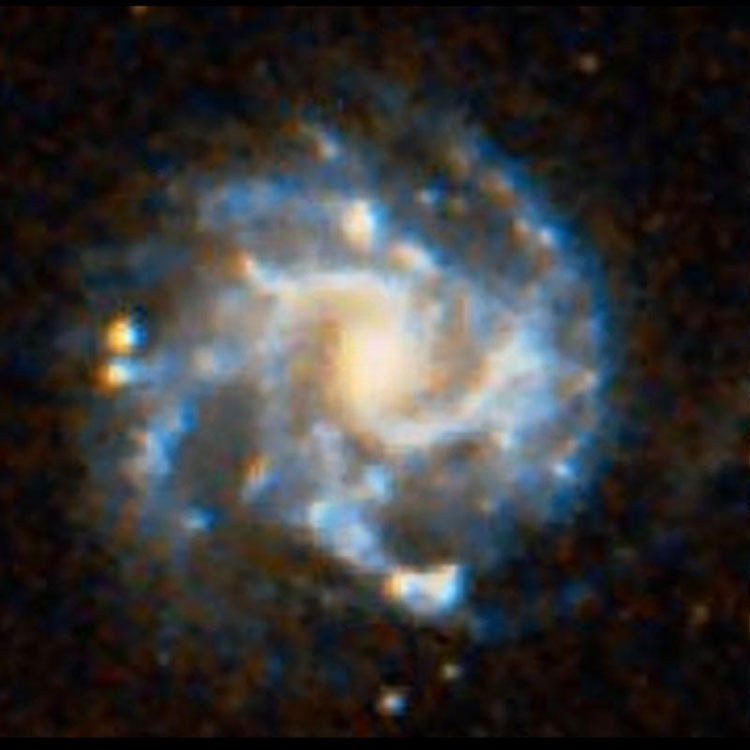
Below, a 3.25 by 3 arcmin wide image of the galaxy
(Image Credit & © Carnegie-Irvine Galaxy Survey; used by permission)
Below, a 2.75 arcmin wide image of the galaxy
(Image Credit ESA/Hubble & NASA, W. Li et al.; Acknowledgement Judy Schmidt)
NGC 5469 (probably = PGC 50740)
(= CGCG 074-136)
Discovered (1883) by Wilhelm Tempel
A magnitude 14.2 lenticular galaxy (type S0?) in Bo�tes (RA 14 12 29.9, Dec +08 38 53)
Historical Identification: Per Dreyer, NGC 5469 (Tempel list VIII, 1860 RA 13 59 24, NPD 79 53) is "very faint, pretty small, round."
Note About HyperLEDA Misidentification: LEDA lists PGC 50309 as NGC 5469, hence its entry immediately below.
Alternative Identification:
Physical Information: Apparent size 0.5 by 0.4 arcmin.
PGC 50309 (perhaps = NGC 5469)
A magnitude 12.9 star in Bo�tes (RA 14 06 24.2, Dec +09 26 12)
Though not his first choice (namely PGC 50740, discussed above), Corwin lists this as a possible candidate for NGC 5469, and it is listed as such in LEDA, but misidentified as a galaxy.
NGC 5470
(= PGC 50317 = UGC 9020 = CGCG 046-050 = MCG +01-36-019)
Discovered (Apr 17, 1830) by John Herschel
Also observed (date?) by Heinrich d'Arrest
A magnitude 13.4 spiral galaxy (type Sb?) in Virgo (RA 14 06 31.9, Dec +06 01 46)
Historical Identification: Per Dreyer, NGC 5470 (= GC 3785 = JH 1749, d'Arrest, 1860 RA 13 59 33, NPD 83 17.4) is "faint, much extended, very gradually a little brighter middle."
Physical Information: Apparent size 2.5 by 0.4 arcmin.
NGC 5471, a star cloud in M101
(= PGC 165629)
Discovered (Aug 22, 1863) by Heinrich d'Arrest
A magnitude 14.7 star cloud in M101, in Ursa Major (RA 14 04 29.1, Dec +54 23 49)
Historical Identification: Per Dreyer, NGC 5471 (= GC 5757, d'Arrest, 1860 RA 13 59 34, NPD 34 56.1) is "faint, small, round, 12th or 13th magnitude star preceding (to the west)."
Physical Information: Apparent size 0.6 by 0.5 arcmin.

Above, a 26 arcmin wide SDSS image of M101, showing its extended arms
Below, the image above showing labels for NGC objects "connected with" the galaxy
Below, a 1.1 arcmin wide PanSTARRS image of NGC 5471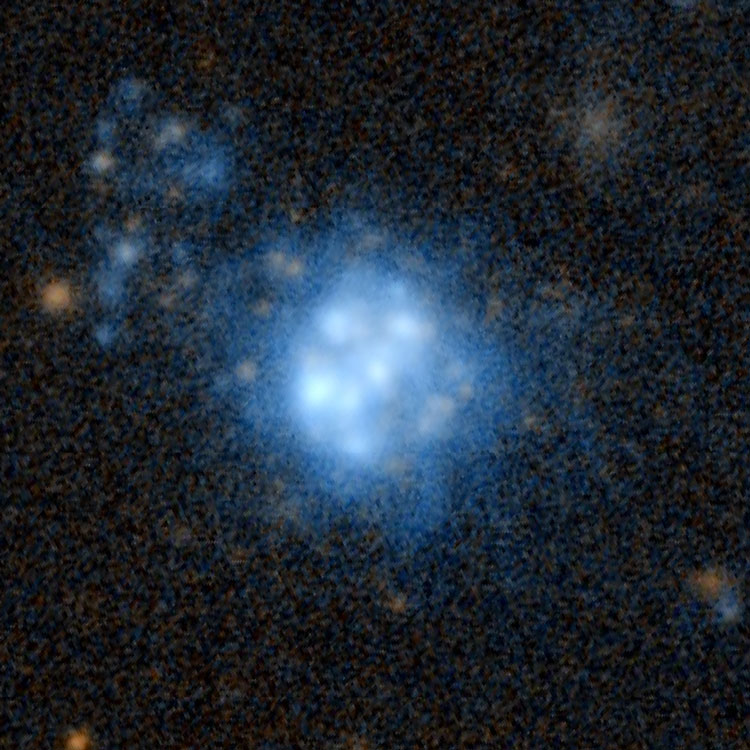
NGC 5472
(= PGC 50345 = MCG -01-36-008)
Discovered (Apr 19, 1855) by R. J. Mitchell
Also observed (April? 1882) by Wilhelm Tempel
A magnitude 14.0 spiral galaxy (type Sab?) in Virgo (RA 14 06 55.0, Dec -05 27 38)
Historical Identification: Per Dreyer, NGC 5472 (= GC 3781, 3rd Lord Rosse, Tempel list V, 1860 RA 13 59 40, NPD 94 47.5) is "pretty faint, very small, between 2 very faint stars."
Discovery Notes: Although Dreyer credits the discovery to William Parsons, 3rd Earl of Rosse, he notes that many of Rosse's nebular discoveries were actually made by one of his assistants, in this case R. J. Mitchell.
Physical Information: Apparent size 1.2 by 0.3 arcmin.
NGC 5473
(= PGC 50191 = UGC 9011 = CGCG 272-022 = MCG +09-23-031)
Discovered (Apr 14, 1789) by William Herschel
Also observed (May 2, 1831) by John Herschel
A magnitude 11.5 lenticular galaxy (type E/SB0?) in Ursa Major (RA 14 04 43.2, Dec +54 53 34)
Historical Identification: Per Dreyer, NGC 5473 (= GC 3782 = JH 1748 = WH I 231, 1860 RA 13 59 50, NPD 34 25.8) is "pretty bright, small, round, gradually brighter middle."
Physical Information: Apparent size 2.2 by 1.7 arcmin.
NGC 5474
(= PGC 50216 = UGC 9013 = CGCG 272-023 = MCG +09-23-032)
Discovered (May 1, 1788) by William Herschel
A magnitude 10.8 spiral galaxy (type Sc?) in Ursa Major (RA 14 05 01.4, Dec +53 39 44)
Historical Identification: Per Dreyer, NGC 5474 (= GC 3783 = WH I 214, 1860 RA 13 59 59, NPD 35 40.3) is "pretty bright, large, brighter middle."
Physical Information: Apparent size 4.7 by 4.7 arcmin.
NGC 5475
(= PGC 50231 = UGC 9016 = CGCG 272-024 = MCG +09-23-033)
Discovered (Apr 14, 1789) by William Herschel
Also observed (May 4, 1831) by John Herschel
A magnitude 12.6 spiral galaxy (type Sa?) in Ursa Major (RA 14 05 12.4, Dec +55 44 31)
Historical Identification: Per Dreyer, NGC 5475 (= GC 3784 = JH 1750 = WH II 800, 1860 RA 14 00 22, NPD 33 35.2) is "pretty bright, small, pretty much extended, brighter middle."
Physical Information: Apparent size 1.9 by 0.5 arcmin.
NGC 5476
(= PGC 50429 = MCG -01-36-009)
Discovered (Mar 5, 1785) by William Herschel
Also observed (Apr 16, 1828) by John Herschel
A magnitude 12.8 spiral galaxy (type Sd?) in Virgo (RA 14 08 08.5, Dec -06 05 32)
Historical Identification: Per Dreyer, NGC 5476 (= GC 3786 = JH 1751 = WH III 287, 1860 RA 14 00 49, NPD 95 25.6) is "faint, pretty small, irregularly round."
Physical Information: Apparent size 1.5 by 1.2 arcmin.
NGC 5477
(= PGC 50262 = PGC 2470340 = UGC 9018 = CGCG 272-025 = MCG +09-23-034)
Discovered (Apr 14, 1789) by William Herschel
Also observed (date?) by Guillaume Bigourdan
A magnitude 14.0 spiral galaxy (type Sm?) in Ursa Major (RA 14 05 32.8, Dec +54 27 39)
Historical Identification: Per Dreyer, NGC 5477 (= GC 3787 = WH III 790, 1860 RA 14 00 54, NPD 34 52.3) is "very faint, pretty large." The second IC lists a corrected RA (per Bigourdan) of 14 00 34.
Physical Information: Apparent size 1.6 by 1.3 arcmin.
NGC 5478
(= PGC 50430 = UGC 9034 = CGCG 018-055 = MCG +00-36-019)
Discovered (Mar 23, 1789) by William Herschel
A magnitude 13.6 spiral galaxy (type SBbc?) in Virgo (RA 14 08 08.5, Dec -01 42 08)
Historical Identification: Per Dreyer, NGC 5478 (= GC 3788 = WH III 762, 1860 RA 14 00 56, NPD 91 01.4) is "very faint, very small."
Physical Information: Apparent size 1.1 by 0.8 arcmin.
NGC 5479
(= PGC 50282 = CGCG 317-016 = MCG +11-17-019)
Discovered (Jun 11, 1884) by Lewis Swift
A magnitude 14.0 lenticular galaxy (type E/S0?) in Ursa Minor (RA 14 05 57.4, Dec +65 41 27)
Historical Identification: Per Dreyer, NGC 5479 (Swift list IV (#14), 1860 RA 14 01 24, NPD 23 37.8) is "extremely faint, very small, round, nearly between 2 stars."
Physical Information: Apparent size 0.7 by 0.5 arcmin.
Corwin lists a possible companion (PGC 50279) at RA 14 05 53.3, Dec +65 42 28
and another (PGC 50272) at RA 14 05 50.8, Dec +65 43 00
NGC 5480
(= PGC 50312 = UGC 9026 = CGCG 272-027 = MCG +09-23-035)
Discovered (May 15, 1787) by William Herschel
Also observed (date?) by Guillaume Bigourdan
A magnitude 12.1 spiral galaxy (type Sc?) in Ursa Major (RA 14 06 21.6, Dec +50 43 30)
Historical Identification: Per Dreyer, NGC 5480 (= GC 3789 = WH II 692, 1860 RA 14 01 25, NPD 38 37.3) is "faint, pretty small, very gradually brighter middle, north-preceding (northwestern) of 2," the other being NGC 5481. The second IC lists a corrected RA (per Bigourdan) of 14 01 11.
Physical Information: Apparent size 1.6 by 1.0 arcmin.
NGC 5481
(= PGC 50331 = UGC 9029 = CGCG 272-028 = MCG +09-23-036)
Discovered (May 15, 1787) by William Herschel
Also observed (date?) by Guillaume Bigourdan
A magnitude 12.3 elliptical galaxy (type E2?) in Bo�tes (RA 14 06 41.3, Dec +50 43 24)
Historical Identification: Per Dreyer, NGC 5481 (= GC 3790 = WH II 693, 1860 RA 14 01 43, NPD 38 37.8) is "faint, very small, suddenly much brighter middle, south-following (southeastern) of 2," the other being NGC 5480. The second IC lists a corrected RA (per Bigourdan) of 14 01 29.
Physical Information: Apparent size 1.8 by 1.5 arcmin.
NGC 5482
(= PGC 50459 = UGC 9038 = CGCG 074-115 = MCG +02-36-043)
Discovered (Mar 19, 1784) by William Herschel
A magnitude 12.9 lenticular galaxy (type S0?) in Bo�tes (RA 14 08 30.7, Dec +08 55 55)
Historical Identification: Per Dreyer, NGC 5482 (= GC 3791 = WH III 59, 1860 RA 14 01 43, NPD 80 24.3) is "extremely faint, small."
Physical Information: Apparent size 1.2 by 0.6 arcmnin.
NGC 5483
(= PGC 50600 = ESO 271-019 = MCG -07-29-008)
Discovered (Mar 15, 1836) by John Herschel
A magnitude 11.2 spiral galaxy (type SBc?) in Centaurus (RA 14 10 25.0, Dec -43 19 29)
Historical Identification: Per Dreyer, NGC 5483 (= GC 3792 = JH 3557, 1860 RA 14 01 46, NPD 132 39.3) is "pretty faint, very large, round, very gradually brighter middle."
Physical Information: Apparent size 3.9 by 3.6 arcmin.
NGC 5484
(= PGC 50338 = PGC 2488231 = CGCG 272-029)
Discovered (Apr 14, 1789) by William Herschel (and later listed as NGC 5485)
Looked for but not found (date?) by Heinrich d'Arrest (while listed as WH I 232)
Also observed (date?) by Guillaume Bigourdan (while listed as NGC 5485)
A magnitude 14.7 elliptical galaxy (type E2?) in Ursa Major (RA 14 06 48.2, Dec +55 01 48)
Historical Identification: Per Dreyer, NGC 5484 (= GC 3793 = WH III 791, 1860 RA 14 02 00±, NPD 34 20±) is "very faint, small, round, 4 arcmin from I 232 (d'Arrest not found)," (WH) I 232 being NGC 5485. The second IC lists a corrected position (per Bigourdan) of RA 14 02 36, NPD 34 15.
Physical Information: Apparent size 0.8 by 0.7 arcmin.
Corwin lists a possible companion (SDSS J140638.13+545947.6 = "PGC 3484941") at RA 14 06 38.2, Dec +54 59 48
NGC 5485
(= PGC 50369 = UGC 9033 = CGCG 272-030 = MCG +09-23-037)
Discovered (Apr 14, 1789) by William Herschel
A magnitude 11.4 lenticular galaxy (type S0?) in Ursa Major (RA 14 07 11.4, Dec +55 00 06)
Historical Identification: Per Dreyer, NGC 5485 (= GC 3794 = WH I 232, 1860 RA 14 02 20, NPD 34 19.9) is "considerably bright, round, very gradually brighter middle, following (eastern) of 2," the other being NGC 5484.
Physical Information: Apparent size 2.3 by 1.9 arcmin.
NGC 5486
(= PGC 50383 = UGC 9036 = CGCG 272-031 = MCG +09-23-038)
Discovered (Apr 14, 1789) by William Herschel
A magnitude 13.2 spiral galaxy (type Sm?) in Ursa Major (RA 14 07 25.0, Dec +55 06 11)
Historical Identification: Per Dreyer, NGC 5486 (= GC 3795 = WH II 801, 1860 RA 14 02 34, NPD 34 14.0) is "faint, pretty large."
Physical Information: Apparent size 1.5 by 0.9 arcmin.
NGC 5487
(= PGC 50537 = CGCG 046-061 = MCG +01-36-021)
Discovered (Mar 22, 1868) by George Searle
A magnitude 14.0 spiral galaxy (type SBbc?) in Bo�tes (RA 14 09 43.9, Dec +08 04 09)
Historical Identification: Per Dreyer, NGC 5487 (G. M. Searle (#324, HN 36), 1860 RA 14 02 43±, NPD 81 17±) is "extremely faint (place uncertain)."
Physical Information: Apparent size 0.9 by 0.4 arcmin.
NGC 5488 (= IC 4375)
(= PGC 50423 = PGC 678102 = ESO 384-058 = MCG -05-33-048)
Discovered (Jun 8, 1837) by John Herschel (and later listed as NGC 5488)
Discovered (April, 1900) by DeLisle Stewart (and later listed as IC 4375)
A magnitude 11.7 spiral galaxy (type SBbc?) in Centaurus (RA 14 08 03.1, Dec -33 18 54)
Historical Identification: Per Dreyer, NGC 5488 (= GC 3796 = JH 3558, 1860 RA 14 02 46, NPD 122 58.6) is "faint, round, 8th magnitude star near to south."
Physical Information: Apparent size 3.4 by 1.0 arcmin.
NGC 5489
(= PGC 50701 = ESO 271-021)
Discovered (Jul 1, 1834) by John Herschel
A magnitude 12.2 spiral galaxy (type Sa?) in Centaurus (RA 14 12 00.7, Dec -46 05 19)
Historical Identification: Per Dreyer, NGC 5489 (= GC 3797 = JH 3559, 1860 RA 14 03 10, NPD 135 25.6) is "very faint, small, round, brighter middle."
Physical Information: Apparent size 1.5 by 1.0 arcmin.
Corwin lists a possible companion (PGC 50552) at RA 14 09 51.4, Dec +17 35 14
NGC 5490
(= PGC 50558 = UGC 9058 = CGCG 103-095 = MCG +03-36-065)
Discovered (Mar 14, 1784) by William Herschel
Also observed Mar 23, 1827) by John Herschel
A magnitude 12.1 lenticular galaxy (type E/SAB0?) in Bo�tes (RA 14 09 57.3, Dec +17 32 44)
Historical Identification: Per Dreyer, NGC 5490 (= GC 3798 = JH 1752 = WH III 32, 1860 RA 14 03 17, NPD 71 47.3) is "considerably faint, considerably small, round, suddenly brighter middle like faint double star."
Physical Information: Apparent size 2.4 by 1.9 arcmin.
PGC 50572
(CGCG 103-097 = MCG +03-36-067 = "NGC 5490B")
Not an NGC object but listed here because sometimes called NGC 5490B
A magnitude 14.9 spiral galaxy (type Sc?) in Bo�tes (RA 14 10 03.8, Dec +17 33 05)
Physical Information: Apparent size 0.6 by 0.4 arcmin.
PGC 50584 (= Arp 79)
(= CGCG 103-100 = MCG +03-36-069 = "NGC 5490C")
Not an NGC object but listed here because sometimes called NGC 5490C
A magnitude 14.2 spiral galaxy (type SB(s)bc) in Bo�tes (RA 14 10 06.9, Dec +17 36 57)
Physical Information: Based on a recessional velocity of 5465 km/sec, PGC 50584 is about 255 million light years away. Given that and its apparent size of 1.2 by 0.8 arcmin, it is about 90 thousand light years across. The galaxy is listed as Arp 79, which is supposed to mean it is a spiral galaxy with a large high surface brightness companion, but there is no sign of such a companion on the corresponding Arp Atlas plate, and the assignment was presumably made merely on the basis of the increased brightness in the star-forming regions on the southwest side of the galaxy.
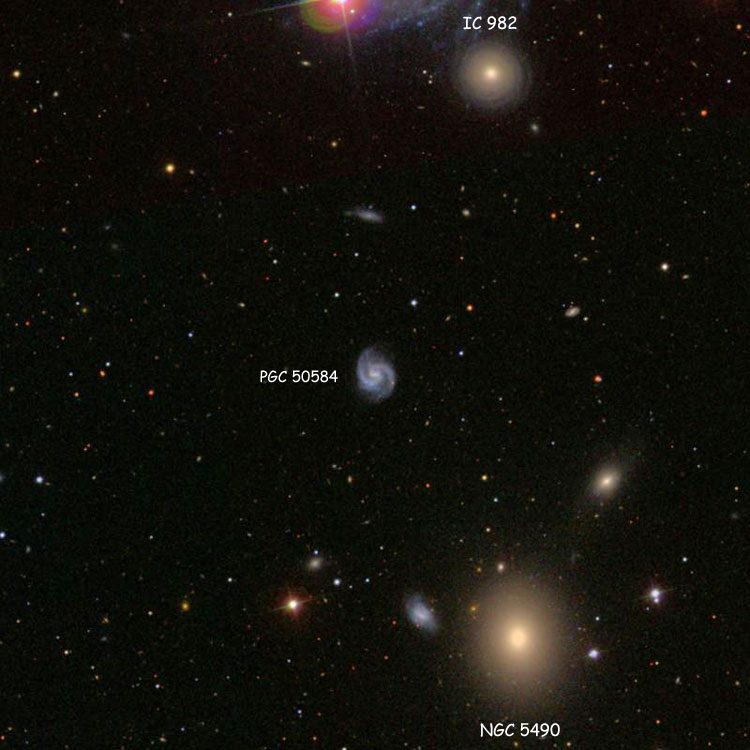
Above, a 12 arcmin wide SDSS image centered on PGC 50584, also showing NGC 5490 and IC 982
Above, a 2.4 arcmin wide SDSS image of PGC 50584
NGC 5491
(= PGC 50630 = UGC 9072 = CGCG 046-063 = MCG +01-36-022)
Discovered (May 12, 1793) by William Herschel
Also observed (May 9, 1828) by John Herschel
A magnitude 12.9 spiral galaxy (type Sb?) in Virgo (RA 14 10 57.4, Dec +06 21 53)
Historical Identification: Per Dreyer, NGC 5491 (= GC 3799 = JH 1753 = WH II 890, 1860 RA 14 04 00, NPD 82 58.2) is "pretty bright, pretty small, round, gradually brighter middle, mottled but not resolved."
Physical Information: Apparent size 1.4 by 0.8 arcmin.
PGC 214225
(= "NGC 5491B")
Not an NGC object but listed here because sometimes called NGC 5491B
A magnitude 15.7 compact galaxy (type C?) in Virgo (RA 14 10 57.8, Dec +06 22 18)
Physical Information: Apparent size 0.3 by 0.2 arcmin.
NGC 5492
(= PGC 50613 = UGC 9065 = CGCG 103-106 = MCG +03-36-074)
Discovered (Apr 20, 1792) by William Herschel
Also observed (Mar 23, 1827) by John Herschel
Also observed (Apr 11, 1882) by �douard Stephan
A magnitude 12.8 spiral galaxy (type Sb? pec) in Bo�tes (RA 14 10 35.2, Dec +19 36 44)
Historical Identification: Per Dreyer, NGC 5492 (= GC 3800 = JH 1754 = WH II 876, 1860 RA 14 04 01, NPD 69 43.8) is "pretty bright, very small, extended."
Physical Information: Apparent size 1.6 by 0.4 arcmin.
NGC 5493
(= PGC 50670 = PGC 1050090 = UGCA 386 = MCG -01-36-013)
Discovered (Feb 22, 1787) by William Herschel
Also observed (Apr 16, 1828) by John Herschel
A magnitude 11.4 lenticular galaxy (type S0?) in Virgo (RA 14 11 29.4, Dec -05 02 37)
Historical Identification: Per Dreyer, NGC 5493 (= GC 3801 = JH 1755 = WH IV 46, 1860 RA 14 04 11, NPD 94 22.7) is "pretty bright, very small, round, pretty suddenly much brighter middle like a star, 18th magnitude star involved."
Physical Information: Apparent size 1.7 by 1.5 arcmin.
Corwin lists an apparent companion () at 14 11 19.1, -05 04 47
NGC 5494
(= PGC 50732 = ESO 446-025 = MCG -05-34-001)
Discovered (Mar 30, 1835) by John Herschel
Also observed (Feb 22, 1898) by Lewis Swift
Also observed (date?) by Herbert Howe (while looking for Swift XI #167)
A magnitude 11.8 spiral galaxy (type Sc?) in Centaurus (RA 14 12 24.2, Dec -30 38 38)
Historical Identification: Per Dreyer, NGC 5494 (= GC 3802 = JH 3560, 1860 RA 14 04 16, NPD 119 59.8) is "pretty bright, large, round, gradually brighter middle, partially resolved (some stars seen)." The second IC adds "I assume Swift XI #167, RA 14 04 31, NPD 119 52.1, faint, pretty small, round, not found by Howe, to be = 5494."
Physical Information: Apparent size 2.3 by 2.1 arcmin.
NGC 5495
(= PGC 50729 = ESO 511-010 = MCG -04-34-001)
Discovered (May 13, 1834) by John Herschel
Discovered (Jun 6, 1868) by Joseph Winlock
Also observed (date?) by Herbert Howe
A magnitude 12.6 spiral galaxy (type SBc?) in Hydra (RA 14 12 23.4, Dec -27 06 29)
Historical Identification: Per Dreyer, NGC 5495 (= GC 3803 = JH 3561, 1860 RA 14 04 24, NPD 116 26.9) is "very faint, small, round, brighter middle, star south-following (to southeast)." The second IC notes (per Howe) "the star is northeast, not southeast; 10th magnitude."
Physical Information: Apparent size 1.5 by 1.2 arcmin.
NGC 5496
(= PGC 50676 = UGC 9079 = CGCG 018-074 = MCG +00-36-026)
Discovered (Apr 23, 1881) by Edward Holden
A magnitude 12.1 spiral galaxy (type SBcd?) in Virgo (RA 14 11 37.8, Dec -01 09 27)
Historical Identification: Per Dreyer, NGC 5496 (Holden (#16), 1860 RA 14 04 24, NPD 90 29.5) is "pretty bright, very large, extended north-south."
Physical Information: Apparent size 4.7 by 0.9 arcmin.
NGC 5497
(= PGC 50610 = UGC 9069 = CGCG 219-054 = MCG +07-29-048)
Discovered (Apr 30, 1870) by �douard Stephan
A magnitude 14.1 spiral galaxy (type SBb?) in Bo�tes (RA 14 10 31.6, Dec +38 53 37)
Historical Identification: Per Dreyer, NGC 5497 (Stephan list XII (b#59), 1860 RA 14 04 43, NPD 50 26.6) is "extremely faint, small, round, a little brighter middle."
Physical Information: Apparent size 1.2 by 0.7 arcmin.
Corwin lists a possible companion (PGC 214222) at RA 14 10 31.4, Dec +38 53 54
and another (PGC 50594) at RA 14 10 21.6, Dec +38 53 16
NGC 5498
(= PGC 50639 = UGC 9075 = CGCG 132-080 = CGCG 133-003 = MCG +04-33-043)
Discovered (Apr 26, 1870) by �douard Stephan
A magnitude 13.6 lenticular galaxy (type E/S0?) in Bo�tes (RA 14 11 04.5, Dec +25 41 53)
Historical Identification: Per Dreyer, NGC 5498 (Stephan list XII (b#60), 1860 RA 14 04 43, NPD 63 38.5) is "faint, small, round, a little brighter middle, mottled but not resolved?"
Physical Information: Apparent size 1.0 by 0.8 arcmin.
NGC 5499
(= PGC 50623 = UGC 9074 = CGCG 191-060 = MCG +06-31-076)
Discovered (May 4, 1870) by �douard Stephan
A magnitude 13.6 lenticular galaxy (type S0/a?) in Bo�tes (RA 14 10 47.6, Dec +35 54 49)
Historical Identification: Per Dreyer, NGC 5499 (Stephan list XII (b#61), 1860 RA 14 04 51, NPD 53 25.4) is "faint, small, round, gradually brighter middle, mottled but not resolved?"
Physical Information: Apparent size 0.9 by 0.6 arcmin.

Above, a 12 arcmin wide SDSS image centered on NGC 5499
Below, a 2.4 arcmin wide SDSS image of the galaxy